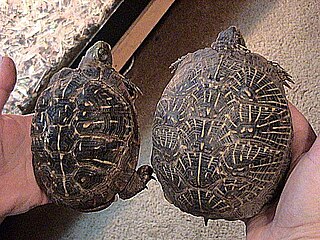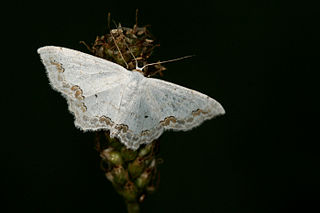
Smilax ornata is a perennial trailing vine with prickly stems that is native to Mexico and Central America. Common names include sarsaparilla, Honduran sarsaparilla, and Jamaican sarsaparilla.

The Sri Lanka blue magpie or Ceylon magpie is a brightly coloured member of the family Corvidae, found exclusively in Sri Lanka. This species is adapted to hunting in the dense canopy, where it is highly active and nimble. Its flight is rather weak, though, and is rarely used to cover great distances. In spite of the Sri Lanka blue magpie's ability to adapt to the presence of humans, it is classified as vulnerable to extinction due to the fragmentation and destruction of its habitat of dense primary forest in the wet zone of southern Sri Lanka.

Terrapene ornata is a species of North American box turtle sometimes referred to as the western box turtle or the ornate box turtle. It is one of two recognized species of box turtle in the United States, having two subspecies. The second recognized species of box turtle is the eastern box turtle,Terrapene carolina. T. carolina has six subspecies, two of which are endemic to Mexico.

Banksia ornata, commonly known as desert banksia, is a species of shrub that is endemic to south-eastern continental Australia. The Ngarrindjeri people of the Lower Murray region in South Australia know it as yelakut. It has thin bark, serrated, narrow egg-shaped leaves with the lower end towards the base, cream-coloured flowers in a cylindrical spike, and later, up to fifty follicles in each spike, surrounded by the remains of the flowers.

The European White Elm cultivar Ulmus laevis 'Ornata' was erroneously identified by Carrière as U. communis ornata in 1858. 'Ornata' was named by Carrière for the numerous and intensely green leaves which gave the trees 'a magnificent appearance'.

Nothoprocta is a genus of birds belonging to the tinamou family Tinamidae. They inhabit scrubland, grassland and open woodland in western South America, particularly in the Andes. They are poor fliers and spend most of their time on the ground. Their diet includes seeds and insects. They nest on the ground, laying large glossy eggs. The eggs are covered with feathers when a potential predator is nearby.

The ornate box turtle is one of only two terrestrial species of turtles native to the Great Plains of the United States. It is one of the two different subspecies of Terrapene ornata. It is the state reptile of Kansas and Nebraska. It is currently listed as threatened in Illinois and is of concern and protected in six Midwestern states.

Scopula ornata, the lace border, is a moth of the family Geometridae. The species was first described by Giovanni Antonio Scopoli in his 1763 Entomologia Carniolica. It is found in Europe, North Africa and the Near East.

The ornate slider is turtle belonging to the genus Trachemys of the family Emydidae. It is found in Guerrero, Jalisco, Nayarit and Sinaloa in western Mexico.
Serixia is a genus of longhorn beetles of the subfamily Lamiinae, containing the following species:
Serixia buruensis is a species of beetle in the family Cerambycidae. It was described by Stephan von Breuning in 1958.
Serixia cinereotomentosa is a species of beetle in the family Cerambycidae. It was described by Stephan von Breuning in 1958.
Serixia novaebritanniae is a species of beetle in the family Cerambycidae. It was described by Stephan von Breuning in 1958.
Serixia longicornis is a species of beetle in the family Cerambycidae. It was described by Francis Polkinghorne Pascoe in 1858.
Serixia prolata is a species of beetle in the family Cerambycidae. It was described by Francis Polkinghorne Pascoe in 1858.
Serixia sedata is a species of beetle in the family Cerambycidae. It was described by Francis Polkinghorne Pascoe in 1862.
Serixia phaeoptera is a species of beetle in the family Cerambycidae. It was described by Per Olof Christopher Aurivillius in 1927.
Serixia atritarsis is a species of beetle in the family Cerambycidae. It was described by Maurice Pic in 1929.
Serixia inconspicua is a species of beetle in the family Cerambycidae. It was described by Gardiner in 1936.

The Southeast Asian softshell turtle is a species of softshell turtle in the family Trionychidae.









